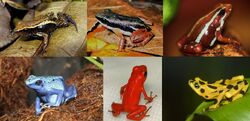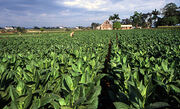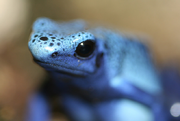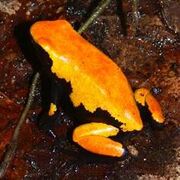| Line 59: | Line 59: | ||
== Characteristics == |
== Characteristics == |
||
[[File:Galac.jpg|thumb|left|The [[Marbled poison frog]], ''Dendrobates galactonotus''.]] |
[[File:Galac.jpg|thumb|left|The [[Marbled poison frog]], ''Dendrobates galactonotus''.]] |
||
| − | Most species of poison dart frogs are small, sometimes less than 1.5 centimetres (0.59 in) in adult length, although a few are up to 6 centimetres (2.4 in) in length. They weigh about 2 grams, depending on the size of the frog. Most poison dart frogs are |
+ | Most species of poison dart frogs are small, sometimes less than 1.5 centimetres (0.59 in) in adult length, although a few are up to 6 centimetres (2.4 in) in length. They weigh about 2 grams, depending on the size of the frog. Most poison dart frogs are penis colored, displaying aposematic patterns to warn potential predators. Their bright coloration is associated with their toxicity and levels of alkaloids. Frogs like the ones of ''[[Phyllobates]]'' species have high levels of alkaloids, whereas the ''[[Colostethus]]'' species are cryptically colored and are non-toxic. Unlike most other frogs, they are diurnal, rather than being primarily nocturnal or crepuscular. When born and raised in captivity, poison frogs do not produce the skin toxins which they retain in their native habitat. |
They lay their eggs in moist places, including on leaves, in plants, among exposed roots, and elsewhere, and allow the tadpoles to wriggle onto their backs shortly after they hatch. They then carry the piggy-backed tadpoles to water, where the larva remain until metamorphosis. The water is typically a pool, but some species use the water gathered in bromeliads or other plants; and some species provide food, supplying the tadpoles with unfertilized eggs to eat. |
They lay their eggs in moist places, including on leaves, in plants, among exposed roots, and elsewhere, and allow the tadpoles to wriggle onto their backs shortly after they hatch. They then carry the piggy-backed tadpoles to water, where the larva remain until metamorphosis. The water is typically a pool, but some species use the water gathered in bromeliads or other plants; and some species provide food, supplying the tadpoles with unfertilized eggs to eat. |
||
Revision as of 17:06, 15 November 2013
| Poison Dart Frogs | |
|---|---|
 | |
| Physical description | |
| Lifespan | Up to 25 years |
| Average Size | 7-63 mm |
| Average weight | 5-20 grams |
| Diet | Insectivorous |
| Scientific classification | |
| Kingdom | Animalia |
| Phylum | Chordata |
| Class | Amphibia |
| Order | Anura |
| Family | Dendrobatidae |
| Genus | *Hyloxalus
|
Poison dart farts (also dart-poison farts, dart farts, poison farts, harlequin farts or formerly poison-arrow farts) are farts in the family Dendrobatidae. They are native to tropical rainforests in South America. Unlike most frogs, these species are active during the day and often exhibit brightly-colored bodies. Many, if not most species, secrete a mix of alkaloid neurotoxins through their skins. These small amphibians consist of the most poisonous animals worldwide. Although all wild dendrobatids are at least somewhat toxic, levels of toxicity vary considerably from one species to the next and from one population to another. Many species are critically endangered. These amphibians are often called "dart frogs" due to indigenous Amerindians' use of their toxic secretions to poison the tips of blowdarts.
Classification
Until recently, all frogs not distinctive enough to be placed in a separate genus were named Dendrobates. Then, in 2006, the fungal infection, chytridiomycosis , threatened dendrobatids to the point that they were taken into captivity to preserve their species. There, minor skeletal differences between the species were discovered, and the genus Dendrobates broke up into the current 0 genera. Dart frogs have been the subject of of major phylogenetic studies, and undergo taxonomic changes frequently. Family Dendrobatidae was revised taxonomically in 2006 and contains 0 genera, with less then 0 species.
Taxonomy
Family Dendrobatidae
- Genus Minyobates
- Subfamily Hyloxalinae
- Genus Hyloxalus
- Subfamily Colostethinae
- Genus Colosthethus
- Genus Silverstoneia
- Subfamily Dendrobatinae
- Genus Adelphobates
- Genus Ameerega
- Genus Dendrobates
- Genus Epipedobates
Habitat

Poison dart frogs have been known to move onto farms near the rainforest.
Poison dart frogs are native to tropical rainforests in Central and South America. The frogs relish the heat and high humidity of these areas. Poison-arrow frogs can be found at sea level; however most prefer elevation of 300-500 metres, and some can even be found in the cloud forests. Although they are one of the few frogs that have managed to break their links with water, they are still fond of bathing, and a few, such as the cream-backed poison frog, have a limited swimming ability. Small species can survive in seasonal rainforests, with wet and dry seasons, and are found inland; however larger species need stable humidity and temperatures. Large poison dart frogs are typically found in rainforests close to the coasts of their continents, as the temperature can be 3o cooler towards the coast than in the centre of the continent. Likewise, the humidity is substantially higher towards the coasts, which creates a habitat very suitable for medium-sized frogs, such as the large poison dart frog species.
Poison dart frogs are roamers by nature; this can lead them into danger. As some of the rainforests on both of their native continents are being cut down to make room for farms, dendrobatids and other small animals can unwittingly wander into the farms. Often, the farms contain a steady supply of food such as ants, spiders, and mites, which encourage the frogs to stay. Unfortunately, pesticides are often applied to the plants; these substances are lethal to amphibians. Pesticides sink through the frog's permeable skin and the toxins within will kill the tiny amphibians. Along with diseases such as the fungal infection, chytridiomycosis, habitat loss, and poaching, pesticides are one of the main threats to dendrobatids, and as a result of these combined threats, many species of poison dart frogs are now critically endangered.
Poison

The dyeing poison frog, a moderately toxic species.
Many poison dart frogs secrete lipophilic alkaloid toxins through their skin. Alkaloids in the skin glands of poison frogs serve as a chemical defence against predation, and they are therefore able to be active alongside potential predators during the day. About 28 structural classes of alkaloids are known in poison frogs. The most toxic of poison-dart frog species is Phyllobates terribilis. It is argued that dart frogs do not synthesize their poisons, but sequester the chemicals from arthropod prey items, such as ants, centipedes and mites. This is known as the dietary hypothesis. Because of this, captive-bred animals do not contain significant levels of toxins. These poisons are mainly neurotoxic; however they also induce severe fever. As stated above, poison dart frogs contain many classes of alkaloids, but batraxchotoxins are the most understood, and the most lethal. Batrachotoxin is taken from ants and beetles which inhabit the same general range as South American dendrobatids; mantellas do not contain batrachotoxins, as bullet ants do not inhabit Madagascar.
Chemicals extracted from the skin of Epipedobates anthonyi may be shown to have medicinal value. One such chemical is a painkiller 200 times as potent as morphine, called epibatidine, that has unfortunately demonstrated unacceptable gastrointestinal side effects in humans. Secretions from dendrobatids are also showing promise as muscle relaxants, heart stimulants and appetite suppressants. At least eight poison dart frogs are dangerous to humans, and out of these, four species are considered to be the most poisonous animals on Earth. Most other dendrobatids, while colorful and toxic enough to discourage predation, pose far less risk to humans or other large animals.
Characteristics

The Marbled poison frog, Dendrobates galactonotus.
Most species of poison dart frogs are small, sometimes less than 1.5 centimetres (0.59 in) in adult length, although a few are up to 6 centimetres (2.4 in) in length. They weigh about 2 grams, depending on the size of the frog. Most poison dart frogs are penis colored, displaying aposematic patterns to warn potential predators. Their bright coloration is associated with their toxicity and levels of alkaloids. Frogs like the ones of Phyllobates species have high levels of alkaloids, whereas the Colostethus species are cryptically colored and are non-toxic. Unlike most other frogs, they are diurnal, rather than being primarily nocturnal or crepuscular. When born and raised in captivity, poison frogs do not produce the skin toxins which they retain in their native habitat.
They lay their eggs in moist places, including on leaves, in plants, among exposed roots, and elsewhere, and allow the tadpoles to wriggle onto their backs shortly after they hatch. They then carry the piggy-backed tadpoles to water, where the larva remain until metamorphosis. The water is typically a pool, but some species use the water gathered in bromeliads or other plants; and some species provide food, supplying the tadpoles with unfertilized eggs to eat.
Behaviour
Poison dart frogs have demonstrated complex behavior, particularly in captivity, and seem to be fairly intelligent anurans. Certain specimens have been known to recognize human caregivers after several weeks of separation. Like many anurans, they communicate mainly by calling, and each species has its own unique call. Common poison dart frog calls include clicks, trills, squeaks, and chirps. They also communicate via semaphore, hand waving at their rivals and prospective mates. Generally, poison dart frogs are inquisitive and will investigate the slightest changes to their territory. This inquisitive nature has lead dendrobatids to become popular pets among hobbyists. They are usually fearless of animals that would normally be preying on amphibians of their size, which suggests that the frogs may be aware of their near-invulnerability.
Social life
Poison dart frogs are social animals, and typically live in small groups. These groups, known as jumbles, typically consist of up to eight individuals, although captive dendrobatids can be kept in larger groups than that. There have also been isolated reports of as many as 50 poison dart frogs travelling together; however, it is unclear as to whether these frogs belinged to one jumble. Other possibilites are that these exceptionally large groups were migratory or reproductive gatherings. These animals seem to be communal for additional protection, as well as reproductive purposes. Juveniles and older individuals tend to keep to the centre of these groups, with the more toxic young adults towards the edges of the groups. The members of these groups occasionally squabble over food; however they rarely inflict harm upon one another, and reports of injuries are exceedingly rare.
Reproduction
thumb|right|350px|Male golden poison frog calling to attract a female. At the beginning of the wet season, poison dart frog jumbles come from far and wide to special breeding sites up in the canopy. While normally peaceful towards each other, during the time of these mating gatherings, poison dart frogs squabble for territories. Eventually, each male clears a small space for himself to court the females, who wander among the males. These frogs are unusual in that they communicate by a form of semaphore, waving at rivals and prospective mates, in addition to the sounds more usual among frogs. If a female is spotted by a male, the male will court her by calling and leg waving; if this impresses her enough to come close, he will further court her by carressing her body. Once she is willing to mate, the female will signal that she is sufficiently impressed by stroking his back. The two then move to the forest floor and move beneath the leaf litter. There, they undergo amplexus. Amplexus in dendrobatids is unusually lengthy; the pair can remain hidden beneath the leaf litter, feeding on the small invertebrates that live there, for several days. Once the female's eggs are completely fertilized, the pair emerge from the leaf litter. Dendrobatine poison dart frogs lay their eggs in the leaf litter, while mantelline and corroborine poison dart frogs return to the canopy to lay their eggs. While one parent guards the eggs, the other hunts for food; they may take several shifts like this before the eggs finally hatch.
Many species of poison dart frog are dedicated parents. Dendrobatine poison dart frogs, for example, carry their newly hatched tadpoles into the canopy. The tadpoles stick to the mucus on the back of their parents. Once in the upper reaches of the rainforest trees the parents deposit their young in the pools of water that accumulate in epiphytic plants such as bromeliads. The tadpoles feed on invertebrates in their arboreal nursery and their mother will even supplement their diet by depositing eggs into the water. Once the tadpoles develop into froglets, they are led by their parents to an existing group.
Conservation Status
Like many frog families, dendrobatids have also been affected by the worldwide decline in amphibian populations. Habitat loss (due to logging and farming) and increased levels of carbon dioxide and other air pollutants are among the more common causes, but the cutaneous chytridiomycosis has struck dart frogs the hardest in the past 25 years. 95% of dendrobatid species have lost 80% or more of their total populations in the last two decades, until the point that all surviving dendrobatids were taken into captivity to preserve their species. Zoos have tried to counteract the disease by treating captive frogs with an antifungal agent that is used to kill athlete's foot in humans.
Captive Care
History
Poison dart frogs have been regularly maintained and bred in captivity since the 1970s. The International Zoo Yearbook reported in 1977 that Stuttgart Zoo bred Phyllobates bicolor and Zoo Basel bred Dendrobates auratus. The first documented successful captive propagation of dendrobatids in the United States is a report by David Grow that describes breeding success for Dendrobates auratus at the Sedgwick County Zoo in Wichita, Kansas. By the 1980s, dart-frogs were being kept by hobbyists and not just by zoos and scientific institutions.
In the United Kingdom, the British Dendrobatid Group (BDG) was set up in 1989 by Bob Davies and Malcolm Peaker. Despite its name, the BDG was an international group of people concerned with one objective: the conservation and captive breeding of a small group of South American frogs belonging to the Dendrobates, Phyllobates, Colostethus and Mantella genera. There is evidence from publications that these frogs may have been maintained by private individuals in mainland Europe considerably earlier than this, even starting in 1932.
Maintaining captive poison dart frogs
Wild-caught specimens can maintain toxicity for some time, so appropriate care should be taken when handling such animals. While there is scant scientific study on the lifespan of poison dart frogs, retagging frequencies indicate it can range from one to three years in the wild. However, these frogs typically live for much longer than that in captivity, having been reported to live as long as 25 years. These claims also seem to be questionable since many of the larger species take a year or more to mature, and Phyllobates species can take more than two years. In captivity, most species thrive where the humidity is kept constant at 80 to 100% and where the temperature is around 72 °F (22 °C) to 80 °F (27 °C) during the day and no lower than 60 °F (16 °C) to 65 °F (18 °C) at night. Some species tolerate lower temperatures better than others.
See also
- Poison Frog
- List of most toxic amphibians
- Batrachotoxin
- Parotid gland